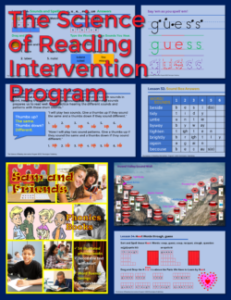
Don’t Assess What You Can’t Teach
In my following criticisms of the CORE and LETRS phonics screeners, I’m reminded that it’s unfair to criticize a duck for being a duck.
Of the plethora of literacy screeners, especially ones which focus on decoding (phonics) and encoding (spelling), the CORE 2nd edition and LETRS Phonics and Word Reading Survey 3rd edition are certainly the most popular. The former has been around for ages and helped pioneer the combined pseudoword and real word approach to phonics assessments. The latter has achieved prominence due to the widespread LETRS training and the omnipresent Dr. Louisa Moats.
These ducks do what ducks do. They are reliable and valid measurements of phonics acquisition. Using these assessments to place students in appropriate tiered instruction will do that job nicely, and they can be used to serve for program evaluation purposes. However, you can’t make a duck walk on all fours. And to beg the question, if you really need a quadruped, why are you using a duck?
Yes, we need to use data for program placement and evaluation; however, other animals can do these jobs and better provide teachers what they need. KEY POINT: Simply put, we need to replace screening assessments with specific and comprehensive diagnostic assessments. Specific and comprehension diagnostic assessments can accomplish all three functions: placement, program accountability (I prefer progress monitoring), and teachable data.
I would caution teachers that using the CORE and LETRS phonics screeners for instructional decision-making is ill-advised. Unfortunately, many teachers use data gleaned from these surveys to place students within small groups on in software modules which introduce or remediate phonics and spelling deficits. Both screeners have included language in their administration directions suggesting this application of their data.
The CORE 1st edition states, “These assessments are best used to plan instruction for students in the primary grades and to develop instructional groups.” Fortunately, the authors of the 2nd edition directions delete this language and suggest that other assessments should be added for instructional decision-making. The LETRS directions state, “The survey is a tool for identifying which correspondences and patterns the student has learned, and which ones the student needs to be taught.” The LETRS verbiage clearly overstates. Although much more comprehensive than the CORE screener, LETRS still uses random sampling and does not identify all correspondences and patterns learned and all those which need to be taught.
One example (the long /u/) should prove my point that the CORE and LETRS phonics screeners should not be used as diagnostics to introduce or remediate phonics and spelling. The CORE 1st edition provides only 1 long /u/ test item, lute. The CORE 2nd edition does not include any long /u/ test items. LETRS does provide 3 long /u/ words: tune, pruse, and commune; however, I’d hazard to guess that any LETRS-trained teacher could tell me why more data should be required to place students in a small group for long /u/ instruction. Most teachers would want to see not only the “u_e,” but also the “u,” “_ew,” and “_ue” sound-spellings on a decoding and spelling diagnostic to make informed instructional decisions.
My point is that we have plenty of diagnostic phonics and spelling assessments that will test those 4 long /u/ sound-spellings (including my own free-to-use diagnostics which I will provide at the end of the article).
Two more relevant points as to why we need to ditch screeners, such as the CORE and LETRS assessments. They waste precious instructional time, and teachers tend to “throw the baby out with the bath water.”
These screeners are time-consuming. In a class of, say 20 students, each assessment takes about 10-15 minutes per student to administer and a few more minutes to score and record–that’s at least 4 hours of administration time. And the CORE 1st edition recommends re-testing every 4-6 weeks. Yikes! And don’t forget the re-testing! Instructional time is reductive. Losing 4 hours of instruction is certainly not useful for any of those 20 struggling readers.
Because the data derived from these assessments is not specific and comprehensive, teachers can’t use the data to inform instruction. Giving screeners undermines the value of teachable diagnostic assessments. Assessment becomes a “have to fill in the blanks” exercise done to meet the expectations of site administrators or reading specialists/literacy coaches or flashpoints for “academic freedom, I don’t have to do them” confrontations.
Replacing screeners, such as the CORE and LETRS assessments, with diagnostic assessments that provide the data teachers can and want to use to help their students makes sense.
Now, teachers jaded by using unhelpful and time-consuming phonics and spelling assessments may be interested in trying these free phonics and spelling assessments. Each is specific and comprehensive and will help teachers make informed instructional decisions for their students. I find them particularly helpful for older reading intervention students.
Oh, how about administration? Whole class, not individual. Audio files. Self-correcting Google forms (or print if you wish). Recording matrices. Vowel Sounds Phonics Assessment (10:42), Consonant Sounds Phonics Assessment (12:07) , Diagnostic Spelling Assessment (17:32-22:38 both American and Canadian English). Oh, would you mind if I included 5 phonemic awareness assessments, a heart words assessment, a grammar assessment, a mechanics assessment, and academic vocabulary assessments? Will do. Plus, think about the ease of using the audio files and Google forms for new students! Scroll down to get the download link sent immediately to your email.
*****

The Science of Reading Intervention Program
The Science of Reading Intervention Program: Word Recognition includes explicit, scripted, sounds to print instruction and practice with the 5 Daily Google Slide Activities every grades 4-adult reading intervention student needs: 1. Phonemic Awareness and Morphology 2. Blending, Segmenting, and Spelling 3. Sounds and Spellings (including handwriting) 4. Heart Words Practice 5. Sam and Friends Phonics Books (decodables). Plus, digital and printable sound wall cards, speech articulation songs, sounds to print games, and morphology walls. Print versions are available for all activities. First Half of the Year Program (55 minutes-per-day, 18 weeks)
The Science of Reading Intervention Program: Language Comprehension resources are designed for students who have completed the word recognition program or have demonstrated basic mastery of the alphabetic code and can read with some degree of fluency. The program features the 5 Weekly Language Comprehension Activities: 1. Background Knowledge Mentor Texts 2. Academic Language, Greek and Latin Morphology, Figures of Speech, Connotations, Multiple Meaning Words 3. Syntax in Reading 4. Reading Comprehension Strategies 5. Literacy Knowledge (Narrative and Expository). Second Half of the Year Program (30 minutes-per-day, 18 weeks)
The Science of Reading Intervention Program: Assessment-based Instruction provides diagnostically-based “second chance” instructional resources. The program includes 13 comprehensive assessments and matching instructional resources to fill in the yet-to-be-mastered gaps in phonemic awareness, alphabetic awareness, phonics, fluency (with YouTube modeled readings), Heart Words and Phonics Games, spelling patterns, grammar, usage, and mechanics, syllabication and morphology, executive function shills. Second Half of the Year Program (25 minutes-per-day, 18 weeks)
The Science of Reading Intervention Program BUNDLE includes all 3 program components for the comprehensive, state-of-the-art (and science) grades 4-adult full-year program. Scripted, easy-to-teach, no prep, no need for time-consuming (albeit valuable) LETRS training or O-G certification… Learn as you teach and get results NOW for your students. Print to speech with plenty of speech to print instructional components.
Click the SCIENCE OF READING INTERVENTION PROGRAM RESOURCES for detailed program description, sample lessons, and video overviews. Click the links to get these ready-to-use resources, developed by a teacher (Mark Pennington, MA reading specialist) for teachers and their students.
Get the Diagnostic ELA and Reading Assessments FREE Resource:
*****
Grammar/Mechanics
core phonics, letrs phonics, phonics assessments, reading assessments, spelling assessments, sreening assessments









